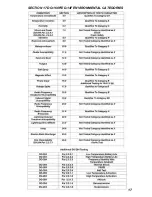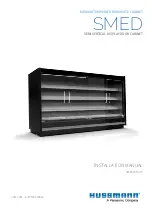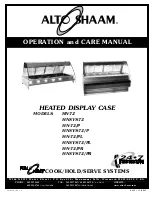
TABLE OF CONTENTS
Section 1 406 MHz ELT overview
Section 2 ELT installation
Section 3 Antenna installation
Section 4 Remote control installation
Section 5 Audio alert indicator installation
Section 6 GPS interface installation
Section 7 Final installation and checkout
Section 8 Registration
Section 9 Operation and self test
Section 10 Periodic maintenance / Continuing airworthiness
Section 11 Lithium battery replacement
Section 12 Programming
Section 13 Warranty procedure
Section 14 Canadian maintenance requirements
Section 15 Specifications
Section 16 Major parts
Section 17 Environmental qualifications DO-160F/ED-14F
Section 18 RS 232 data formats / Installation notes
Section 19 Trouble shooting / Miscellaneous notes
SECTION 1 406 MHz ELT OVERVIEW
The model E-04 121.5/406 MHz ELT is designed for use in aircraft used for general and
commercial aviation. Older generation ELT’s were very limited in their ability to rapidly
locate, and identify a downed aircraft. Often it took several passes of the orbiting satellites
to get an approximate fix on a downed aircraft. The older generation ELT’s gave rescuers
no information on type of aircraft, owner/operator, or contact information. The new
generation 406 MHz ELT’s provide much better, and faster location accuracy. Along with
providing information to search and rescue organizations about the aircraft type,
ownership, and emergency contact information. Location accuracy with older generation
ELT’s was limited to about a 15 - 20 mile radius, and could take several hours to provide
accurate location data. For new generation 406 MHz ELT’s without GPS position
information, the average time to process, and identify the aircraft location is 1-2 hours,
with a search radius of about 2 miles or less. With GPS information, the time to locate the
aircraft position is 10 minutes or less, with an accuracy of about 300 feet. The model E-04
ELT may be installed without interfacing it to the aircraft GPS system,
however we strongly
recommend that when available the GPS data be supplied to the ELT.
For aircraft which do
not have GPS data available, the unit can be interfaced with a low cost GPS data receiver,
such as the Garmin GPS 18PC which is available for less than $75.00. (Note: these
receivers require a 5V supply. One model has a cigarette lighter plug with a built in
regulator, or you can use a 5V switching power supply, such as Digi-Key P/N 811-1116-ND)
You must register this beacon
before activating it.
Failure to do so can result in monetary
fines, and other sanctions. See section 8 for registration instructions.
You must update your registration every two years
.
SECTION 2 ELT INSTALLATION
Several problems associated with previous TSO C-91, and C-91a ELT installations, is the
result of poorly chosen mounting locations. Generally the most suitable location for fixed
wing aircraft, is to position the ELT transmitter in the fuselage as far aft as possible. Anten-
na location, and accessibility for maintenance, are factors that should be considered when
choosing a mounting location. The ELT must be mounted with the arrow printed on the
battery case pointing in the direction of flight. The ELT should be mounted with it’s longi-
tudinal axis aligned within 10 degrees of the longitudinal axis of the aircraft fuselage.
Avoid mounting the ELT near sources of strong EMI/RFI radiation.
RTCA document DO-204 paragraph 3.1.8. prescribes the mounting requirements which
must be met when installing this ELT, these requirements are as follows:
The ELT shall be mounted to primary load-carrying structures such as trusses, bulkheads,
longerons, spars, or floor beams. (not aircraft skin) The mounts shall have a maximum
static local deflection no greater than 2.5mm (0.1 inch) when a force of 450 newton's (100
lbs.) is applied to the mount in the most flexible direction. Deflection measurements shall
2
Содержание E-04
Страница 16: ...16 SECTION 16 MAJOR PARTS ...
Страница 17: ...17 SECTION 17 DO 160F ED 14F ENVIRONMENTAL CATEGORIES ...




























